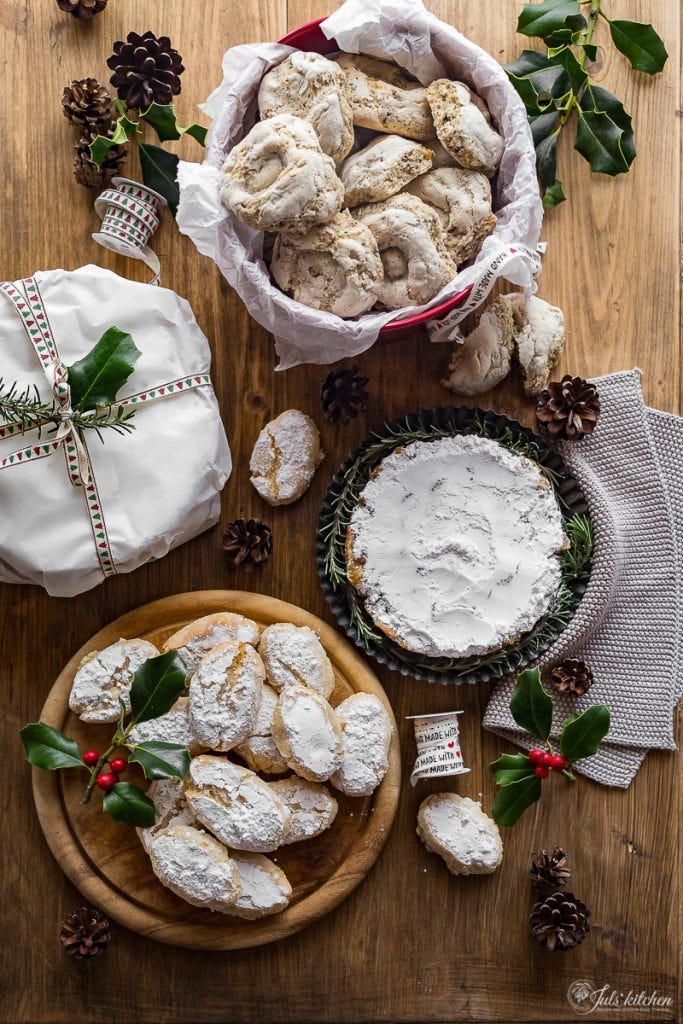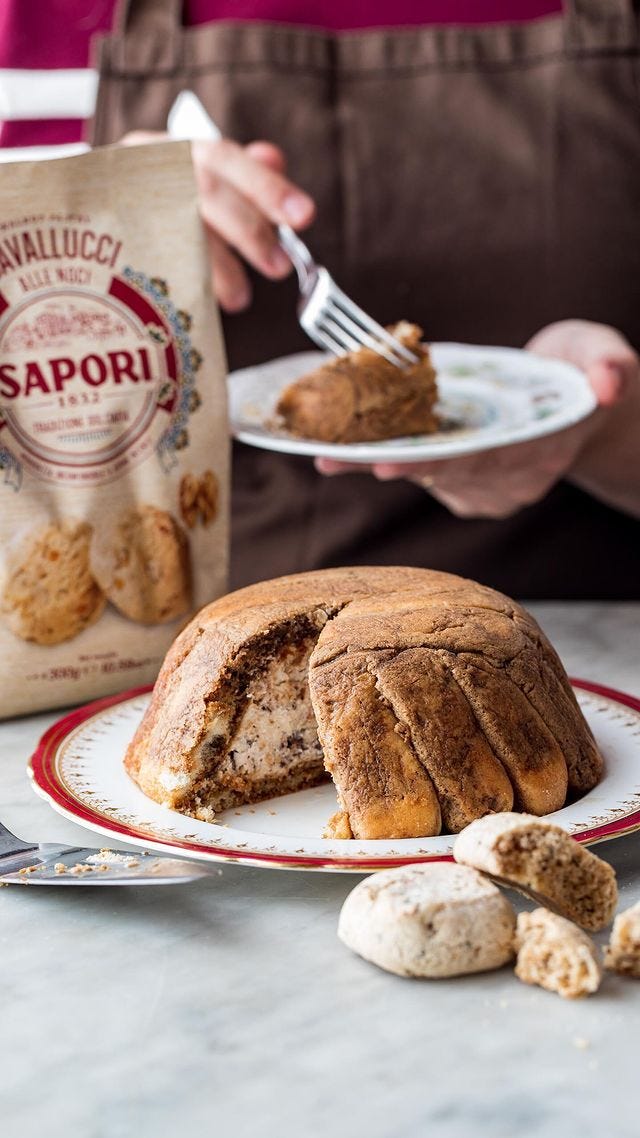Traditional Tuscan sweet treats
We're back with a special Christmas episode of our podcast, Cooking with an Italian Accent!
The best way to understand the Tuscan pastry art is to have a walk in Siena with an open mind, following the trail of spices, paying attention to the colours and to the ingredients of the baked goods arranged in the shop windows of bakeries, cafés, and pastry shops.
The Tuscan pastry art isn’t show-stopping, elegant, refined, or elaborate, as you would say of the French patisserie or even of the Southern Italian pastry art of Sicily and Naples.
In this episode, we will delve into the Tuscan pastry art, and we will discover that:
It is seasonal – strongly connected to seasons and seasonal ingredients, to festivities, celebrations, pagan and religious events. You know when you are in the year from the sweet treats displayed in the shop windows.
It is related to Cucina Povera, the peasant cooking, the art of making do with what you have.
It shows a lasting influence of Medieval and Renaissance ingredients, spices, and traditions.
So now listen to the episode, join the conversation online, and enjoy this little taste of Tuscan sweet treats.
Listen to the new episode here.
Some of the recipes we mentioned in this episode
I’m sure here you could find some inspiration for your festive baking.
Schiacciata con l’uva. In September, a few spoonfuls of sugar and grapes are added to plain bread dough to make a schiacciata traditionally associated with the harvest.
Pan co’ Santi. Late October to mid-November means the arrival of pan co’ santi, a Tuscan sweet, fragrant bread stuffed with raisins and walnuts. Its name derives from an association with All Saints’ Day on November 1.
Cenci. A sweet dough flavoured with orange peel and vinsanto is rolled out very thinly, just like with fresh pasta, and fried into hot olive oil. As soon as the cenci are fished out of the hot oil, they are dusted with icing sugar and sprinkled with sugar.
Rice fritters. The rice fritters used to be made just for St joseph, on the 19th of March, which is also when we celebrate Father’s Day in Italy. Now they are common also for Carnival, probably under the influence of the tons of fritters fried in Italy for Carnival.
Schiacciata alla Fiorentina. Despite its name that reminds of the savoury flatbread so typical of all our bakeries, schiacciata alla fiorentina is a sweet cake, fragrant with orange and vanilla.
Quaresimali.Quaresimali are biscuits made from egg whites, sugar and flour, with the addition of hazelnuts and cocoa, orange zest and, sometimes, a pinch of cinnamon. They take the shape of letters of the alphabet, they have a glossy surface and are cracked and rough underneath.
Pan di Ramerino. It was made and eaten exclusively during the Holy Week before Easter. Now it is possible to purchase and enjoy pan di ramerino in many Florentine bakeries throughout the year, but years ago it was on sale just for the Holy Thursday, when it was brought to be blessed to the church.
Schiacciata di Pasqua. Easter in Siena, as in the Val d'Elsa, means la schiacciata di Pasqua—a leavened bread flavoured with rose petal syrup and anise, which takes its name not from the shape (schiacciata is a flatbread whose name means "squashed"), but rather from the large amount of eggs "smashed" in its preparation.
Necci. Necci are thin pancakes with crisp edges, belonging to Garfagnana and the Pistoia Mountains, nothing more than simple crêpes made just with chestnut flour and water, that could be then eaten plain or filled with sausage, pancetta or ricotta.
Castagnaccio. The simplest version involves a basic mix of chestnut flour, water, oil and rosemary, resulting in a cake with an almost biting, smoky flavour and a texture similar to bread pudding.
Zuccotto. Zuccotto, a traditional semifreddo dessert from the city of Florence, is a showstopper: a sponge cake dome, brushed crimson with a local liqueur, alchermes, and filled with a mixture of ricotta and whipped cream, chocolate, and candied fruits.
Zuppa Inglese. If you make zuppa inglese in a transparent bowl, something I really love to do, you will see a colorful stack of layers: yellow vanilla custard; a darker chocolate custard; pinkish savoiardi (ladyfingers) dunked in alchermes.
Cantucci. The typical Tuscan almond biscuits, well-known and appreciated all over the world. They can be enjoyed alone, served with coffee and tea or, according to tradition, dipped in liquorish wine such as “vin santo”.
Cavallucci. Despite their humble appearance—floury, and a bit lumpy—with that first bite of warm spices, rich nuttiness, and sweet candied fruit you’ll forget all about presentation.
Ricciarelli. They are shaped like grains of rice and have a rough surface which is dusted with icing sugar. They were first made in the fourteenth century for Tuscan aristocrats based on an Oriental recipe.
Panforte. This unique bread dates to the Middle Ages, first made in monasteries to give on special occasions. This dense, spiced, nut-filled speciality bread has become the symbol of Siena.
Here you can see how we turned a zuccotto into a festive snack!
Support us by joining our paid newsletter
When we first launched our subscription-based newsletter back in March, we thought it was mainly about sharing recipes. We could not believe it could become for you an anchor to Italy, to the Italian table and our loud conviviality, a reason to experiment with less known ingredients, the voice of a friend in the kitchen.
At the monthly cost ($5) of a gelato with double whipped cream, or at the annual cost ($40) of a good bottle of extra virgin olive oil, you can support our own independent publication directly.
It is demanding to keep this newsletter active, interesting, and useful for you, on a twice a week basis and in two languages. For us it is like curating our own food magazine: we share seasonal recipes, essays, menu ideas, stories, ingredient insights, links, and travel tips. When you join Letters from Tuscany, you know you will receive twice a week some valuable content in your inbox, just like when your favourite food magazine is dropped at your doorstep.
What you missed recently: Pittule salentine, Sienese Christmas panforte, Rice with butter, Parmigiano, and mozzarella, Chestnut risotto, Saltimbocca alla romana.
Whenever you decide to join us, you will have complete access to the whole archive of already published recipes and stories.
Thank you for reading! - Giulia and Tommaso
- Give Letters from Tuscany as a Holiday Gift! -
Are you searching for a sustainable and original gift for your loved ones?Don’t look any further! You can gift a subscription to Letters from Tuscany to your friend who wants to learn to cook, or to your daughter who’s missing Italy, or your mum, dad, aunt, brother, grandma… anyone interested in Italian food!
You can schedule your gift to arrive on the date you prefer, and you can even download a gift certificate.






